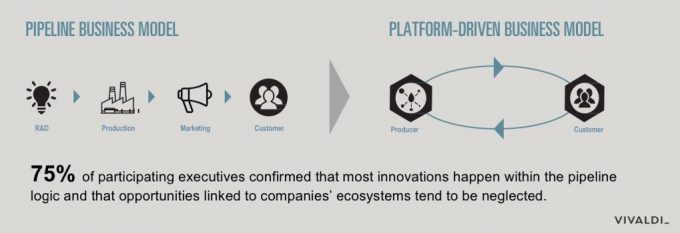The Platform Opportunity: Our key takeaways from meeting with 150+ Decision-Makers
By Vivaldi, October 5, 2018
In management discussions happening everyday across the globe, platform business models are the obsession that companies want to emulate, learn from and launch (and yes, in some cases, from which they want to protect themselves).
But why do so many platform-building endeavors fail to cross the chasm and skyrocket through the roof?
This past year, we explored this question through a series of seven roundtables that led us across the US and Europe to meet over 150 senior marketing and strategy executives. Market leaders from brands including GE, Telefonica, Welbilt, Daimler, Wacom, Grohe, Vorwerk, and PwC, joined us to discuss the opportunities represented by the platform economy in Chicago, New York, Munich, Hamburg, Zurich, London, and Dusseldorf. The diversity of the people, experiences, and industries represented led to immensely rich and inspiring discussions.
“The perspectives can’t be diversified enough to discuss innovative business models – a plea for the Diversity of Thoughts!” – One participant’s feedback
Through discussions with roundtable participants and many of our clients we learned that implementing a platform successfully means tackling several challenges. Below we share nine key insights to keep in mind for a successful outcome:

ORGANIZATIONAL KEYS
#1 Transform your organization from the top down. We heard first hand that complex management structures are a massive obstacle to maximizing innovation across many companies. Establishing a digital or innovation unit outside of the core business can be a solution, but beware that it doesn’t create silos that distance innovation efforts from corporate goals and stakeholder interests. A key success factor is the acceptance and awareness amongst the workforce of how important it is to establish innovative business models. But even more important is the fact that leadership is driving the effort.
#2 Use your company’s assets and resources. In order to compete against innovative players like Amazon via a platform business model, a company has to think strategically about leveraging its existing capabilities and assets. Start by thinking broadly about your company’s ecosystem and how it can generate customer value. Then explore systematically how the existing customerbase, brand equity, industry relationships and intellectual capital can strengthen the platform proposition.
#3 Find the right people. Establishing the technical feasibility of a platform is often a bottleneck in the preliminary implementation stages. This is especially true given the shortage of in-house IT specialists and directly affects the ability of companies to execute on an idea in an agile way, from MVP design and approval to iterative in-market tests. Solutions shared by the executives we spoke with were to create interdisciplinary teams and/or retrain employees before starting external recruiting procedures.
STRATEGIC KEYS
#4 Think visionary. Operational issues tied to the daily business can reduce the innovative power of the most forward-thinking teams. We heard that companies lose their strategic vision when management teams get bogged down by more short-term goals around performance measurement, compensation systems, or investment returns. To counter this, leadership has to move away from old pipeline thinking and adjust its business cycle to consider changing market demands and fast-moving business models.
#5 Make your enemy your friend. In many cases, the competitive advantages of established players – typically, financial power and resource strength – are becoming obsolete. The reason? The growing venture capital culture allows new players to rapidly establish financial strength. By avoiding the EBIT trap, they are more agile, able to take on more risk and represent a greater threat to incumbents. The best response is to convert potential competitors into partners early on. Collaborating with agile new players offers the opportunity for established companies to benefit from synergies, to be exposed to new business models, and in some instances, to reap monetary benefits.
CULTURAL KEYS
#6 Find the potential in your ecosystem. Embracing platform thinking offers new opportunities to interact with and benefit from your company’s ecosystem. Playing the long game of cooperating with competitors, suppliers, or other players will ultimately create new customer value and if structured the right way, will generate exponential growth. One piece of advice is that the opportunity to engage and collaborate with platform participants becomes more apparent when diving into how each stakeholder can contribute and benefit from the platform.

#7 Shared value mindset. Collaborating with competitors to leverage each others core competencies can be counter-intuitive to many companies. However, in the world of platforms, customer value is created through the complex interplay of all platform participants — not only along a single company’s value chain. Making connections within the ecosystem and democratizing knowledge is essential to platform success. Just don’t let your competitor know about your end-goal of industry domination when you approach them, and talk more about shared value creation!
CUSTOMER-CENTERED OFFERING
#8 Learn from data. Data is a strategic and valuable asset with incredible potential. To take advantage of this potential, the right data competencies are required in order to get to, and benefit from, actionable insights. While in the past the main focus was on collecting data, gaining relevant insights and monetizing data is the core task of today. It is essential to know where valuable data can be collected and how it can be leveraged to create new value. Only then can a relevant and personalized offering be created for the customer in such a way that it increases profitability for the company itself.
#9 Always think of the customer problem first. Platforms reduce the complexity of everyday problems with the goal of making people’s lives easier. This happens through the seamless integration of single services into a bundled solution – simultaneously representing the value streams of all platform participants. In comparison to existing business models, platforms make it quicker and easier for companies to solve customer problems and satisfy their needs.
* * *
We want to thank our clients and network for joining us and contributing to the exciting discussions and lively knowledge exchange on platform business models.
If this post raised any questions on platform business models or you want to be part of our next Vivaldi Roundtable, feel free to email us at hello@vivaldigroup.com.
- Topics:
- Platform Strategy
Meet The Expert

Dr. Markus Zinnbauer
Senior Partner
Markus Zinnbauer is a Senior Partner and the head of Vivaldi’s analytics practice. He brings deep and practical expertise in quantitative methods and brand management strategy.
